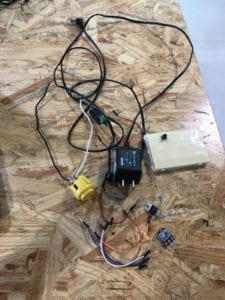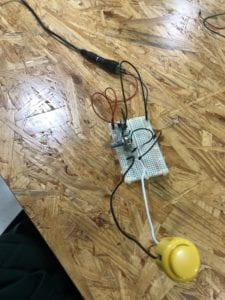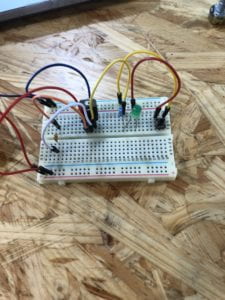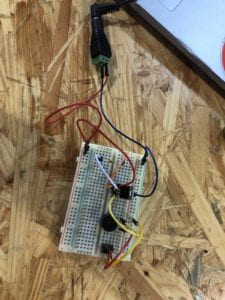The process of building circuits was a time of learning new skills revolving around electricity and connections. Touching circuits for the first time, I was confused at how the diagram could translate to the actual circuit and how connections were made between components of the circuit. Through a long process of experimentation as well as guidance from instructors and fellows, I began to understand how the circulation of electricity worked and how each component played a part in the circuit.
I began to understand how the breadboard worked where the numbered rows were connected and different numbers weren’t, how (-) rows implied ground while (+) implied power input. After this understanding was established, the next components would then be understood where the barrel jack was a link from the power source to the bread board; the capacitor stores electricity allowing for the movement of electricity; the jumper cables allow for electricity fluidity between components; the resistor allows for reduced current for the LED light which protects it from overheating; the switch/arcade button can end or start the flowing of electricity to the LED light; the LED emits energy (light); the voltage regulator regulates the voltage; the power supply distributes electricity from the power cord and converts it to 12V which allows for safe circulation of electricity for the components; and the variable resistor can mend the resistivity applied to the LED to control the charge being circulated to the LED which controls the emission of energy (light).

Through this process of learning what each component of the circuit does, I was creating the actual circuits which encountered many issues. Issues from the circuits included a faulty voltage regulator which did not allow for electricity to flow to the next component for Circuit 1. This was resolved by changing the voltage regulator which allowed for the circuit to be successful. When creating Circuit 3, there was misunderstanding of how the variable resistor should be connected in the circuit where I connected a jumper cable at the two ends of the variable resistor. This resulted in a connection between the power source and light but didn’t allow for the variable resistor to control the flow of current. After changing the jumper cable to connect from the center, it allowed for the variable resistor to control the flow of current (dimming).
Below will be photos and videos of successful circuits from Circuit 1 and 2:

As it can be seen, the sound system works where the switch can turn it on and off.

It can be seen that the light can turn on and off via the switch.
Circuit 3 had key issues with the connections of jumper wires and variable resistor. A video will be attached below to show how incorrect jumper wire connections to the variable resistor didn’t allow the variable resistor to alter the current to the LED light.
After realizing this error, I amended the placement of the jumper wire which allowed for the variable resistor to alter the current allowing for the dimming and brightening of the LED light.

Question 1
Interactivity is the interaction between two things or objects that have the capacity to react to the action of the other. The circuits built today have limited interactivity with humans. While the interaction between my finger and the switch allow for the result of sound or light, the interaction is limited to a singular action which cannot be amended unless other components are added e.g. the variable resistor. This, however, still resembles limited interactivity as the interactivity between my hand and the switch is one interaction while my hand and the dial of the variable resistor is another interaction. As the interaction is with different objects, the interactivity with the switch doesn’t change.
Question 2
Interaction design and physical computing can be used to create interactive art by having humans use computed objects to create works of art. This could be like iq Font by Zack Lieberman where humans drive the car to write letters or it could be like drawn : where art moves after being drawn which creates art that interacts with human movement.
Leave a Reply